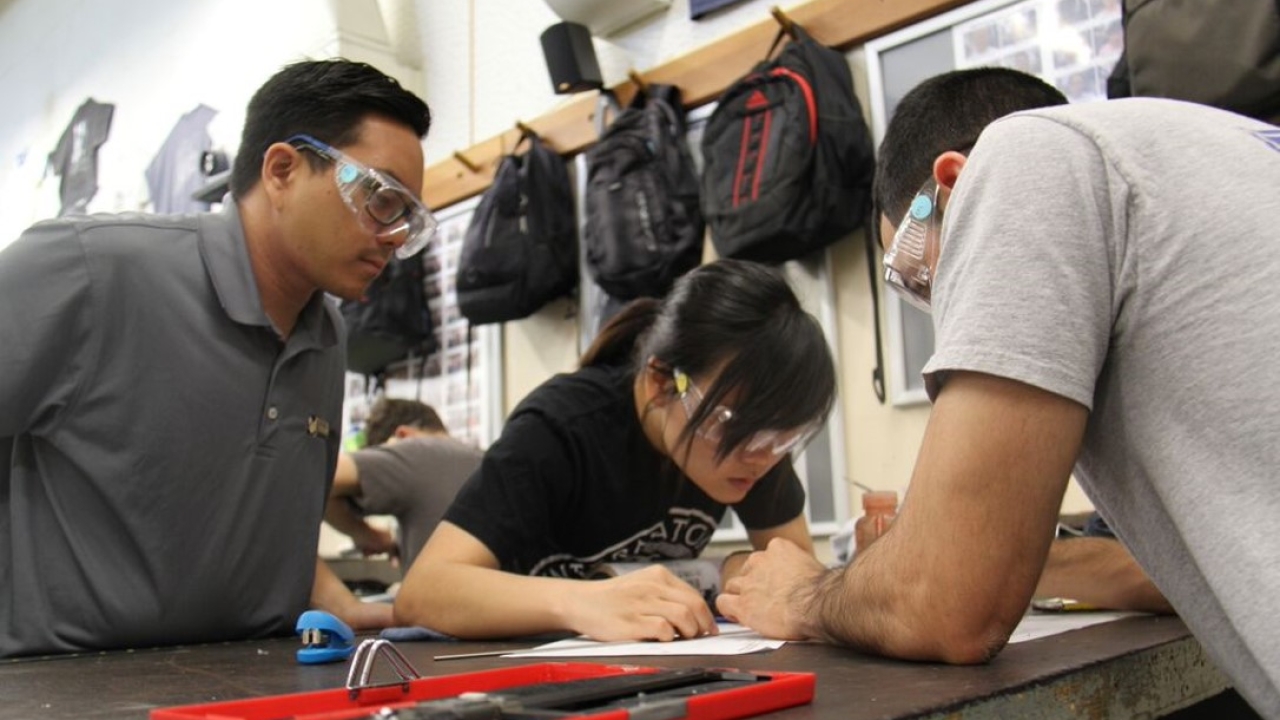
Evolving Hands-On BME Curriculum to Ensure Student Success
Associate Professor Anthony Passerini is passionate about advancing the undergraduate curriculum in biomedical engineering at the University of California, Davis — a mission underscored by the fact he is the Department of Biomedical Engineering's recipient of the 2024 College of Engineering Excellence in Teaching Award.

From forming meaningful partnerships with colleagues to develop new courses to redesigning course syllabi that offer hands-on and foundational knowledge in design and prototyping, Passerini is committed to ensuring undergraduate students succeed in future academic settings and industry employment.
Historic Development
Passerini's efforts to advance the department's undergraduate biomedical engineering curriculum are long-standing.
In 2005, just months after joining the college, Passerini co-developed and co-taught the BME Senior Design series with Professor of Biomedical Engineering Angelique Louie. The capstone, year-long series tasks teams of senior biomedical engineering students to propose and prototype a device or system that addresses a clinical problem.
Their efforts in the course were aided by a project led by Louie, with Passerini as participating program faculty, that was funded by the National Institute of Biomedical Imaging and Bioengineering, or NIBIB, to improve biomedical engineering education at UC Davis. The project focused on translational design and innovation and fostered lasting partnerships with campus entities that included the Clinical and Translational Science Center and the School of Veterinary Medicine.
Passerini said that Louie was instrumental in the series' success and continued development until she stepped away to focus on other parts of the curriculum and administrative needs in 2013.

In 2017, Associate Professor of Teaching Jennifer Choi in the Department of Biomedical Engineering received a grant from NIBIB that sought to refine what Louie began with Passerini through the senior design series. He once again served as a program faculty for the effort, which implemented skills-building modules throughout the curriculum to enhance career readiness for undergraduate students.
"We were hearing a lot from students in engineering that they didn't want to wait until senior year to be hands-on and do something," Passerini said. "They didn't want to be just learning theory from a textbook."
He continued to direct the senior design series through a period of rapid growth in student enrollment through 2018, adapting it to accommodate as many as 25 student teams per year. During this time, he also served as the department's vice chair for education, leading efforts to continuously refine and evolve the BME curriculum.
Entry-Level Design
In 2021, Passerini took over the direction of BIM 20L, a second-year course in computer-aided design, or CAD. The course focuses on the applications of CAD in biomedical engineering using industry-standard software like SolidWorks and developing robust, adaptable product designs.

As part of the department's effort to offer better practical knowledge for its undergraduates, Passerini redesigned the class's labs and exercises to establish good engineering habits early and provide practice with the most common uses of CAD. He also rethought the final project, making it an individual project where students would design parts of a larger assembly, forcing them to think about how their designs interface with those of others as part of a larger picture.
"I was determined to get them started early with thinking about the manufacturability of their designs and making them robust to change," Passerini said. "I encouraged them to think of engineering graphics as a language with rules and structure that are needed to clearly convey all the necessary information about a design to the person who will manufacture it."
By developing and refining this foundation for the basics of design and graphics software, Passerini aims to better equip sophomores with the necessary tools for success in later courses in the program, and to enhance their competitiveness for summer internships.
Rapid Prototyping
In collaboration with Steven Lucero, development engineer and manager of the UC Davis Biomedical Engineering Translating Engineering Advances to Medicine Lab, Passerini developed "Introduction to Rapid Prototyping for BME" from the ground up.

In the upper division course, students build upon CAD skills learned through BIM 20L and are introduced to modern, rapid manufacturing techniques like 3D printing and laser cutting. Students examine examples of 3D-printed medical models to understand how these techniques can be used in biomedical engineering contexts, such as in creating reference models for surgeons.
With this course, Passerini and Lucero aim to fill in knowledge gaps that they initially observed in students entering the senior design series and from years of reviewing senior design projects.
"By the time students got to senior design and were trying to prototype their devices, particularly in the area of things like 3D printing, there was some lack of experience," Passerini said. "They weren't being exposed to more modern, rapid ways of prototyping, which are coming into play more often in the senior design experience."
Through this introduction to modern prototyping techniques, the course prepares students with the practical knowledge necessary to fabricate their projects in the senior design series.
"We've taught it for about five years now, and it has become quite popular and in demand," Passerini said. "It's something we hope to expand in the future."
Continuous Evolution
Passerini notes that making changes to the curriculum is always an extensive process.
"When you have a mature curriculum, it's like pulling one strand of a spider web; you have to think very carefully about how you restructure things because if you move one thing, it affects something else."
Despite the challenges of making curriculum changes, Passerini continues to optimize the BME curriculum for students, keeping feedback from students in mind.
"We routinely survey our exiting seniors and our alums, and that feedback has influenced how we structure and evolve our programs," he said.
In addition, Passerini considers the relatively new nature of biomedical engineering as an undergraduate field as a reason why the biomedical engineering curriculum must continue to be agile and comfortable with change to help students succeed in academia and industry.
"Biomedical engineering is in its infancy and only became an undergraduate degree in the past 20 years or so," Passerini said. "One of our challenges has been to help people understand what a biomedical engineer is and what our students can do."
After nearly two decades of pulling the "spider's web" of curriculum development, Passerini is proud of what he and his colleagues in the department have developed: a curriculum that builds upon engineering principles year after year, is design-centric and prepares biomedical engineering students as highly qualified, well-rounded engineers who can help solve the problems of the future.
"One of my greatest joys as a faculty member has been to hear from former students, now successful professionals, who attribute some fraction of that success to their experience with courses that I had a hand in developing."





